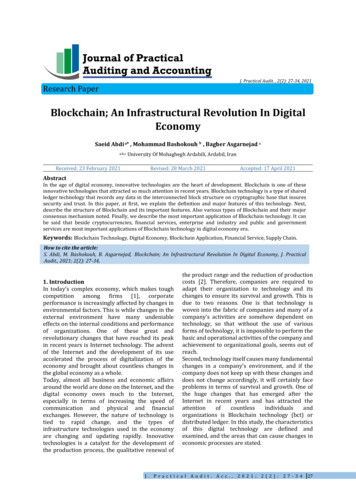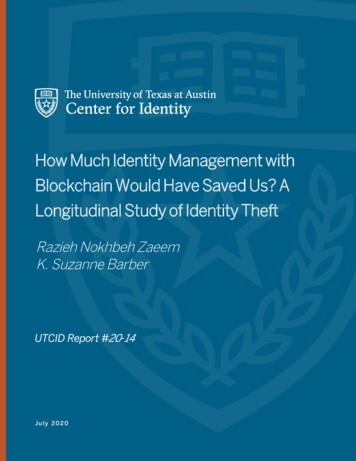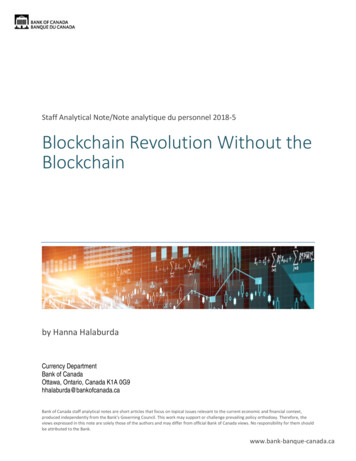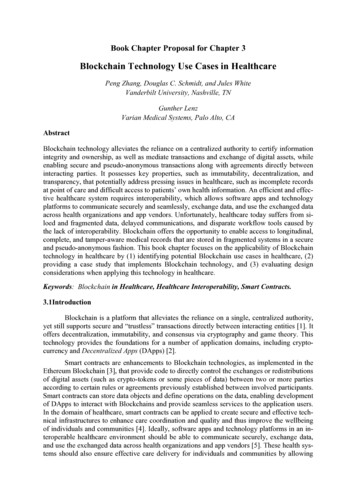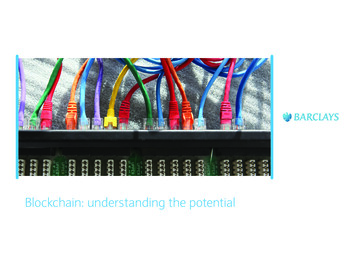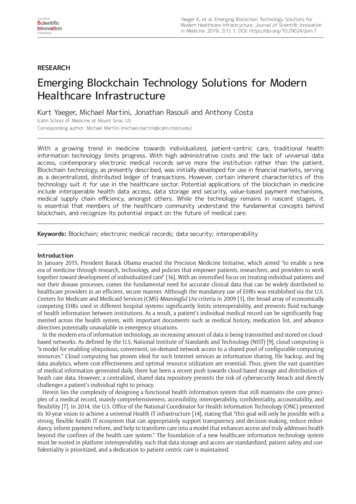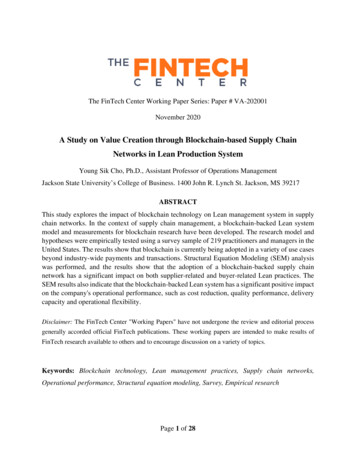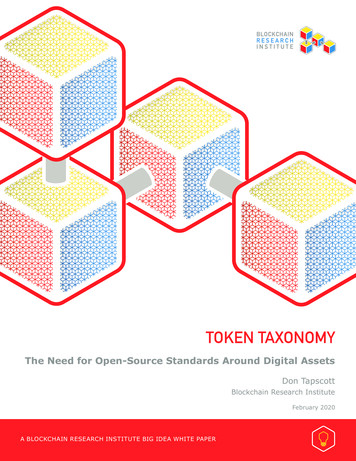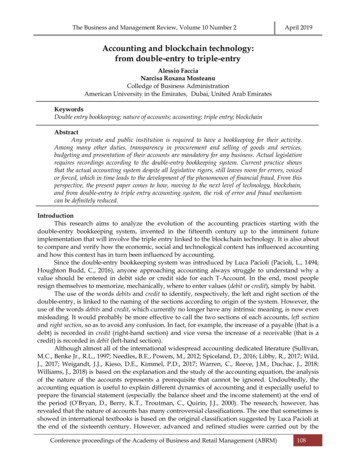
Transcription
The Business and Management Review, Volume 10 Number 2April 2019Accounting and blockchain technology:from double-entry to triple-entryAlessio FacciaNarcisa Roxana MosteanuColledge of Business AdministrationAmerican University in the Emirates, Dubai, United Arab EmiratesKeywordsDouble entry bookkeeping; nature of accounts; accounting; triple entry; blockchainAbstractAny private and public institution is required to have a bookkeeping for their activity.Among many other duties, transparency in procurement and selling of goods and services,budgeting and presentation of their accounts are mandatory for any business. Actual legislationrequires recordings according to the double-entry bookkeeping system. Current practice showsthat the actual accounting system despite all legislative rigors, still leaves room for errors, voicedor forced, which in time leads to the development of the phenomenon of financial fraud. From thisperspective, the present paper comes to how, moving to the next level of technology, blockchain,and from double-entry to triple entry accounting system, the risk of error and fraud mechanismcan be definitely reduced.IntroductionThis research aims to analyze the evolution of the accounting practices starting with thedouble-entry bookkeeping system, invented in the fifteenth century up to the imminent futureimplementation that will involve the triple entry linked to the blockchain technology. It is also aboutto compare and verify how the economic, social and technological context has influenced accountingand how this context has in turn been influenced by accounting.Since the double-entry bookkeeping system was introduced by Luca Pacioli (Pacioli, L., 1494;Houghton Budd, C., 2016), anyone approaching accounting always struggle to understand why avalue should be entered in debit side or credit side for each T-Account. In the end, most peopleresign themselves to memorize, mechanically, where to enter values (debit or credit), simply by habit.The use of the words debits and credit to identify, respectively, the left and right section of thedouble-entry, is linked to the naming of the sections according to origin of the system. However, theuse of the words debits and credit, which currently no longer have any intrinsic meaning, is now evenmisleading. It would probably be more effective to call the two sections of each accounts, left sectionand right section, so as to avoid any confusion. In fact, for example, the increase of a payable (that is adebt) is recorded in credit (right-hand section) and vice versa the increase of a receivable (that is acredit) is recorded in debit (left-hand section).Although almost all of the international widespread accounting dedicated literature (Sullivan,M.C., Benke Jr., R.L., 1997; Needles, B.E., Powers, M., 2012; Spiceland, D., 2016; Libby, R., 2017; Wild,J., 2017; Weigandt, J.J., Kieso, D.E., Kimmel, P.D., 2017; Warren, C., Reeve, J.M., Duchac, J., 2018;Williams, J., 2018) is based on the explanation and the study of the accounting equation, the analysisof the nature of the accounts represents a prerequisite that cannot be ignored. Undoubtedly, theaccounting equation is useful to explain different dynamics of accounting and it especially useful toprepare the financial statement (especially the balance sheet and the income statement) at the end ofthe period (O’Bryan, D., Berry, K.T., Troutman, C., Quirin, J.J., 2000). The research, however, hasrevealed that the nature of accounts has many controversial classifications. The one that sometimes isshowed in international textbooks is based on the original classification suggested by Luca Pacioli atthe end of the sixteenth century. However, advanced and refined studies were carried out by theConference proceedings of the Academy of Business and Retail Management (ABRM)108
The Business and Management Review, Volume 10 Number 2April 2019Italian Doctrine on the analysis of the nature of the accounts. In Italy, the accounts are analyzedunder various aspects and the nature of accounts currently bases the studies of the accounting ofeach Italian University, but it is unfortunately almost still unknown abroad. The translation anddissemination of these analyzes will undoubtedly offer a more complete view of the accountingprocess, not only based on the study of the accounting equation, which represents its synthesis andnot its origin.It is not possible to neglect to describe the reasons that led to the origin of the double entry andthe consequences generated by its introduction. At the end of the 15 th century commercial exchangesin the Mediterranean were very intense, particularly among the Italian maritime republics (includingVenice) and Muslim traders in the Middle East. It is also likely that the double-entry bookkeepingsystem described in the book by Luca Pacioli originated from the possible influence of the practice ofMuslim accounting, practiced and implemented by the Venetians (Zaid, O.A., 2000).The development of industrial companies (starting from the industrial revolution, in theeighteenth century, which allowed mass production) in the whose duration was no longer limited tothe conclusion of a single business, then determined the need to distribute dividends at leastannually. At that time the need to implement adjusting entries also arose. That need, in turn, has ledus to study, above all in Italy, the nature of the accounts, in order to allow to take account of theaccrual basis.Despite the auditing controls, however, commercial frauds have unfortunately alwaysoccurred. The bad accounting practices that lead to an incorrect representation of the financialstatements, however, have become more widespread. Nowadays, given the centrality of accountingpractices and the financial globalization, it is crucial to find a way to curb the challenge.The advanced studies (Yuji I., 1986) on the triple entry synthesized from the very beginning onthe topic (Simoyama, F.D.O., Grigg, I., Bueno, R. L. P., & Oliveira, L.C.D., 2017), have highlightedhow the double entry cannot be considered an absolute system, but it can certainly be improved andevolved.Nowadays, given the globalization of markets, the difficulties in compliance among differenttransnational regulations, the number of transactions and the quickness with which they occur, themain weaknesses that characterize accounting are linked to the following aspects: 1) it is quiteimpossible for auditors to audit all the accounts rendered, and instead, they are forced to select asmall sample for audit based on their level of risk; 2) obsolescence of information, since thepresentation of accounts, through the financial statements, only occurs once a year, leading to aseasonal demand with significant lag time between auditing and accounting period (Shim, J.K., Siegel, J.G.,Dauber, N., Qureshi, A.A., 2014); and, 3) lack of cross-checking of transactions recorded in theaccounts of two counterparties.Blockchain is a new technology that was introduced a decade ago, after financial crisis of 2008(Nakamoto S.,2008), and there is still a long way to being accepted and adopted by everyone.Blockchain can be described as the chronological record of block transactions. To ensure transactions,the cryptography is used, based on a chain of digital signatures. Each block is a group of transactionsthat are added to the last block by reaching a consensus on its authenticity among users, which isthen passed to each network user to update their database. The Blockchain system records alltransactions ever made, shared by consensus distributed and shared among each participant’s users,and it is very difficult to force it. Since every two-key sign-in and any transactions are cryptographedand simultaneously maintained in distributed ledgers of each Node, which make this almostimpossible to be hacked (figure no.1).Figure no.1: Blockchain processConference proceedings of the Academy of Business and Retail Management (ABRM)109
The Business and Management Review, Volume 10 Number 2April 2019The invention of the blockchain that already found an application in finance through thecryptocurrencies, by many is currently considered as the solution to implement the triple entry. Themove to a financial system with a significant blockchain element offered opportunities and newapproaches for accountancy area. Nowadays, blockchain can help accountants to gain clarity over theavailable resources and obligations of their organizations.Research MethodologyThe present work paper is an exploratory research, based on investigative techniques. It is afundamental and qualitative research which aims to present what is the current approach of doubleentry accounting, and a new era: triple-entry ledgers with blockchain.Literature Review3.1. The Double Entry bookkeeping system and the different classification of the nature of accountsIn order to deepen the development of accounting techniques, it is necessary first of all toprovide a complete and analytical framework of the literature review concerning the nature of theaccounts. According to the international classification of the nature of accounts:Real accounts: are considered all assets of a firm, which are tangible or intangible, balance sheetaccount that is carried forward into the next year. It is a proprietary account (Spellman W.L., 2000).Tangible real accounts are related to things that can be touched and felt physically (tool, building,machinery, stock, land). Intangible real accounts are related to things that cannot be touched and feltphysically. (Goodwill, patents, trademarks, software licenses).DEBIT: what comes inCREDIT: what goes outPersonal accounts: accounts related to individuals, firms, companies (debtors, creditors, banks,outstanding/prepaid accounts, accounts of credit customers, accounts of goods suppliers, capital,drawings)Natural personal accounts: related to people (e.g. Mr. X’s A/C, Mrs Y’s A/C ). Artificialpersonal accounts: related to entities created by law (corporations, institutions). Representativepersonal accounts: related to a certain person or a group directly or indirectly (employees, wageprepaid account)DEBIT: the receiverCREDIT: the giverNominal accounts: related to expenses, losses, incomes or gains. Existing by name only, they do notexist in physical form, but related to any nominal account money, income statement account (revenue andexpense) that is closed out at the end of the year (Spellman W.L., 2000).DEBIT: expenses and lossesCREDIT: incomes and gainsThe above-mentioned classification focuses on the material essence of the accounts but has nodirect connection with the accounting equation and it is referred to the initial classification providedby Luca Pacioli (Pacioli, L., 1494).Authoritative scholars in Italy in the twentieth century have largely deepened the study ofnature of accounts to be able to create a simple, intuitive and rigorous system to post the accounts inthe financial statement. The theoretical construction of Gino Zappa (Dagnino, G.B., Quattrone, P.,2006), father of the modern Italian business economics, has defined the earnings system, where theoriginal, numerical accounts, represented by the changes of money and its equivalents, isdistinguished, and the derived aspect, referred to economic measures, economic accounts, which aredistinguished as economic accounts of capital, and earnings economic accounts.The current widespread approach adopted in Italy to identify the nature of the accounts, calledcapital and earnings system, as it is presented by contemporaneous academics (Melis, A., 2007), it outlinesthe original (financial) and derivative (economic) accounts (Manni, F., 1996; Manni, F., 2008; Manni, F.,Faccia A., 2015; Manni, F., Faccia, A., 2019).Conference proceedings of the Academy of Business and Retail Management (ABRM)110
The Business and Management Review, Volume 10 Number 2April 2019Financial accounts include numerical accounts (cash, operating receivables and operatingpayables), in addition to financial receivables and financial payables. Financial accounts (originalaspect: concerns cash inflows & outflows, as well as increases & decreases of receivables andpayables):Certain: current liquidity (cash, bank)DEBIT: increase of cashCREDIT: decrease of cashAssimilated: deferred values (receivables from customers, payables to suppliers, settlementsreceivables and payables), to sum up, operating receivables and payablesDEBIT: increase of credit(or) decrease of debitCREDIT: decrease of credit(or) increase of debitAssumptive: accrued receivables and payables, and fundsDEBIT: increase of credit(or) decrease of debitCREDIT: decrease of credit(or) increase of debitEconomic accounts, on the other hand, include, in addition to multi-annual (that exhaust theirusefulness in more than one period) and operating costs and revenues (that exhaust their usefulnessin one period), also the equity. Economic accounts (derivative aspect allows to identify the causes ofeach financial transaction, cost, revenues, and change in equity):Earnings of the period: costs and revenues of the periodDEBIT: expense(or) revenue reductionCREDIT: revenue(or) expense reductionEarnings multi-annual: economic accounts with two-phase operation (multi-year) – multi-annual:material and intangible assetsDEBIT: durable expense increase(due to purchase, bartering or impairment)CREDIT: durable expense reduction(due to disposal, impairment or depreciation)Earnings suspended: costs and revenues of deferred allocation (inventories and deferral, prepaidexpenses and unearned revenues)DEBIT: expense paid,but still not accruedCREDIT: revenue collected,but still not accruedCapital: accounts related to risk capital (equity) risk capital and reservesDEBIT: capital refund(withdrawal)CREDIT: capital contribution3.2. The Triple Entry bookkeeping system and use of blockchain technologyNowadays double-entry bookkeeping it is not an absolute system, but it is logically extendibleto triple-bookkeeping by including a set of force in its third axis (Yuji, I., 1982). Blockchain, foraccounting industry, helps the companies to write their transactions directly into a join bookkeeping,creating an interlocking system of enduring accounting records. Double entry accounting has beenused for a very long time now. Triple entry accounting adds a level of clarity and honesty tobookkeeping that double-entry accounting cannot offer. Triple entry accounting has address A,address B, and the third address that is the confirmation receipt. The third public ledger allows forboth books to reconcile their ledgers and make sure all three records are in a consensus (Unicorn,2018). It is showing all transactions and all debits and credits involved can be seen. It is how, thesalient feature of double-entry bookkeeping lies in the integration of flow accounts with stockConference proceedings of the Academy of Business and Retail Management (ABRM)111
The Business and Management Review, Volume 10 Number 2April 2019accounts, its logical extension to triple-entry bookkeeping becomes clear, subsequently an integrationof a new set of accounts designed to explain changes in flow accounts (Yuji, I., 1986).Findings and conclusionsThe aim of this research paper is to review the evolution of accounting practices, analyzing themain evolutionary steps that occurred in different historical periods in accordance with social needs.The aim of the research is also to analyze the technical consequences and the advantages determinedby the introduction of the evolutions themselves.The authors have highlighted that at least three periods in which substantial changes haveoccurred can be identified: 1) the origin of scientific accounting, determined according to the writtenaccounting reference (Pacioli, L., 1494); 2) implementation of accounting for enduring businesses,with the introduction of adjusting entries and the study of the nature of the accounts; and, 3) thepossibility of practically implementing the triple entry with the application of blockchain technology.The origin of scientific accounting: double entry bookkeeping systemAt the end of the 15th century commercial exchanges in the Mediterranean were very intense,particularly among the Italian maritime republics (including Venice) and Muslim traders in theMiddle East. It is also likely that the double-entry bookkeeping system described in the book by LucaPacioli originated from the possible influence of the practice of Muslim accounting, practiced andimplemented by the Venetians (Pryor J.H.,1997). Even the name of the “Journal” (in Venice “Zornal”)has a very strong assonance with the equivalent book used in the Middle East “Jaridah” (Zaid, O.A.,2000). Nor can it be ruled out that religion (Spellman W.L., 2000) represented a driving force forinnovation. It is necessary to consider that both the Muslim and the Christian religions, in thathistorical period (the Muslim one still today (Pryor J.H., 1997; Moşteanu, N.R., 2017; Moşteanu, N.R.,2018; Moşteanu, N.R., 2019) forbade, even if to a different extent, the lending of money with interest.However, the merchants’ need to find a source of finance has led to the invention of a new legal formof governance that has made it possible to circumvent the ban (sharing profit instead of charginginterests): the partnership (Pryor J.H.,1997), in which two types of partners are identified: a limitedpartner (limited liability partner), usually the capitalist who wanted to finance a project withoutrisking all his assets, but who still wanted to get a return on their money; and, a general partner(unlimited partner), usually a merchant who wanted to make money and also risked his life bysailing and travelling.The spread of these new ventures forced the merchants to provide detailed reports, through anadvanced accounting practice, to determine the final profit to be shared with the capitalists. Thepartnership forms took on the name of Commenda in Italy and Mudarabah or Qirad in the Middle East,but the model of governance was substantially the same.Accounting for enduring business: adjusting entries and nature of accountsThe industrial revolution was a process of economic evolution and industrialization of thesociety that from an agricultural-craft-commercial system became a modern industrial systemcharacterized by the general use of machines driven by mechanical energy and by the use of newinanimate energy sources (such as for example fossil fuels), all favored by a strong component oftechnological innovation and accompanied by phenomena of growth, economic development andprofound socio-cultural and even political changes. The first industrial revolution mainly involvedthe textile-metallurgical sector with the introduction of the steam engine in the second half of the18th century. The second industrial revolution was conventionally started in 1870 with theintroduction of electricity, chemicals and oil.Conference proceedings of the Academy of Business and Retail Management (ABRM)112
The Business and Management Review, Volume 10 Number 2April 2019Figure no.2: The three-dimensional views of accountsThe industrial revolution involved a profound and irreversible transformation that starts fromthe productive system up to involve the economic system as a whole and the entire social system.The appearance of the factory and the machine changes the relationships between the productivesectors. Thus, was born the working class that received, in exchange for its work and time madeavailable for work in the factory, a salary. The industrial capitalist, an entrepreneur who owns thefactory and the means of production, also arose, which aims to increase the profit of his business. Thelife of the companies begins to lengthen, and the owners express the need to have a return at leastannually. It is therefore necessary to report annually, conventionally and ideally, the profit (positiveor negative) actually accrued over the closing period.Therefore, the complexity of accounting increases with the introduction of adjusting entries(prepaid cost, unearned revenues, depreciation, amortization, unearned receivables and payables .),which were previously unknown because it was not necessary to prepare intermediate reports.Previously, in fact, the closing of the balance sheet was essentially carried out at the conclusion of theaffair (commenda contract), when the merchant returned from the commercial trip and divided theprofits with the limited liability partner.In order to better represent, also visually (figure no. 2), the complexity of the double-entrybookkeeping system, summarized by the accounting equation, the Authors, in this paper, alsoidentify a three-dimensional graphic according to three perspectives: horizontal axis –accountingequation / left side - Assets, right side - Equity & Liabilities; vertical axis – above - economic accounts,below - financial accounts; concentric circles – external circle - long term; inner circle - short term.Accounting for enduring business: triple entry blockcainBlockchain technology continues to grow and is being used in more and more business sectors,accounting has been identified as an area that could greatly benefit the distributed registry and otherfeatures of the blockchain. The main benefits discussed include reducing the risk of error (especiallyhuman error); low risk of fraud (blockchai it is very difficult to penetrate and manipulate); systemautomation, huge cost savings (by increasing the efficiency and decreasing in errors), increasedreliability in financial reports, and reduced workflow.Nowadays many economists and accountants are saying that at the end of the road, fully automatedaudits can be real (Deloitte, 2016). Triple-entry accounting (figure no. 3) is an extension of the double-entrysystem that has been in use since the 16th century (Grigg, I., 2005).Conference proceedings of the Academy of Business and Retail Management (ABRM)113
The Business and Management Review, Volume 10 Number 2April 2019Figure no.3: Triple-entry bookkeepingDouble-entry transaction set up jointly by three parties as a payer, a payee and a payee issuer,as is usually done by banks and their customers. The payer sends units of the beneficiary's money(for example, a check) and the issuer (the bank) is responsible for checking and signing thetransaction, for transferring the money and issuing a receipt for both the payer and the payee toupdate their books. This model offers too much centralized power to the issuer, which would bestrong candidate for internal fraud. In order to reduce the issuer's ability to commit fraud, tripleentry accounting through blockchain brings countless advantage that the three parties involved areguaranteed exactly the same information and no party can enter unauthorized information(Simoyama, F.D.O., Grigg, I., Bueno, R. L. P., & Oliveira, L.C.D., 2017).The basis for triple entries is a unique, cryptographically safe record, called receipt, the fullprobative proof of proof is provided by the digital signatures of the author, the payer and theaccepting issuer, making sure that no party can successfully pass unauthorized transaction is valid.This reduces the problem of accounting with that of its presence or other type of receipt, whichwould be guaranteed by dividing the copies between all parties involved (figure no.4).Figure no.4. Triple-entry accounting system through block technologySource: Dai, J., Vasarhelyi, M., 2017Conference proceedings of the Academy of Business and Retail Management (ABRM)114
The Business and Management Review, Volume 10 Number 2April 2019The new blockchain technology, rules and data layers are already implemented in manyactivities, and the triple-entry with blockchain could be implemented successfully within accountingsystem. This comes with balance checks, asset levels and inter-organizational confirmations of debtsand accounts receivables and would be integrated into the automatic use of smart contracts (Dai, J, &Vasarhelyi, M., 2017).Furthermore, with the permissioned blockchain, different parties / roles can be given differentdata views, restricting access to data to some. Triple-entry account systems through blockchain it canbe programmed to follow accounting standards and regulations automatically using smart contractsand could even automate tax filings through continuous updates.Blockchain technology allows for timely examination of potential errors or fraud within accountingentries (e.g., duplicate payments), as well as automation of transaction verification using data from businesspartners. Moreover, smart contracts encoded with accounting and business rules could enable efficient control ofthe recording process (Dai, J., Vasarhelyi, M., 2017).ReferencesDagnino, G.B., Quattrone, P., 2006. Comparing institutionalisms: Gino Zappa and John R. Commons' accounts of"institution" as a groundwork for a constructivist view. Journal of Management History, 12 (1), pp. 36-52.Dai, J, & Vasarhelyi, M., 2017. Toward Blockchain-Based Accounting and Assurance, Journal Of Information Systems,31, 3, pp. 5-21, Business Source Complete, EBSCOhost.Deloitte, 2016. Blockchain: A game changer for audit processes?, Retrieved rigg, I., 2005. Triple Entry Accounting, Retrieved from http://iang.org/papers/triple entry.htmlHoughton Budd, C., 2016. In the shoes of Luca Pacioli – double entry bookkeeping and financial literacy, InternationalHandbook of Financial Literacy. pp:621-637.Libby, R., 2017. Financial Accounting. McGraw-Hill Higher Education.Needles, B.E., Powers, M., 2012. Financial Accounting. Cengage Learning.Manni, F., 2018. Il percorso logico contabile di costruzione del bilancio ordinario di esercizio. Giappichelli Editore.Manni, F., 1996. Lineamenti di ragioneria generale. Il processo logico-contabile di formazione del bilancio ordinariod'esercizio. Giappichelli Editore.Manni, F., Faccia, A., 2015. Introduction to accounting. Aracne Editrice.Manni, F., Faccia, A., 2019. Financial Accounting - Text and cases. Aracne Editrice.Melis, A., 2007. Financial statements and positive accounting theory: The early contribution of Aldo Amaduzzi.Accounting, Business and Financial History, 17 (1), pp. 53-62.Moşteanu, N.R., 2019. Safety finance – a different approach – Conventional versus Islamic. Conference on Advancesin Social Science, Management and Human Behaviour, Malaysia.Moşteanu, N.R., 2018. The benefit of taxation: Zakat versus income tax. 10 th European Academic Research Conferenceon Global Business, Economics, Finance and Social Science, Paris, France.Moşteanu, N.R., 2017. What is the future of banking industry? Different approach: Islamic vs. Conventional system.Ecoforum Journal, Volume 6, Issue 3(13)Nakamoto, S., 2008. Bitcoin: A peer-to-peer electronic cash system.O’Bryan, D., Berry, K.T., Troutman, C., Quirin, J.J., 2000. Using the accounting equation analysis to teach the statementof cash flows in the first financial accounting course. Journal of accounting education, Vol. 18, Issue 2, Pages 147155.Pacioli, L., 1494. Summa de arithmetica, geometria. Proportioni et proportionalita.Pryor J.H., 1997. The origins of commenda contract. Speculum, vol 52, No.1, The University of Chicago Press.Simoyama, F.D.O., Grigg, I., Bueno, R. L. P., & Oliveira, L.C.D., 2017. Triple entry ledgers with blockchain forauditing. International Journal of Auditing Technology, 3(3), 163-183.Shim, J.K., Siegel, J.G., Dauber, N., Qureshi, A.A., 2014. Dictionary of accounting terms. 6th edition. Barron’s businessGuides.Spellman W.L., 2000. The influence of Religion on the Globalization of Accounting Standards. Trinity Christian College.Spiceland, D., 2016. Financial Accounting. McGraw-Hill Higher Education.Sullivan, M.C., Benke Jr., R.L., 1997. Comparing introductory financial accounting textbooks. Journal of accountingeducation, Vol. 15, Issue 2, Pages 181-220.Unicorn, 2018. Can blockchain truly disrupt the accounting industry?, video retrieved s/finance/accounting/Warren, C., Reeve, J.M., Duchac, J., 2018. Financial Accounting. McGraw-Hill Higher Education.Conference proceedings of the Academy of Business and Retail Management (ABRM)115
The Business and Management Review, Volume 10 Number 2April 2019Weigandt, J.J., Kieso, D.E., Kimmel, P.D., 2017. Financial Accounting. Wiley.Wild, J., 2017. Fundamental Accounting Principles. McGraw-Hill Higher Education.Williams, J., 2018. Financial Accounting. McGraw-Hill Higher Education.Yuji, I., 1982. Triple-Entry Bookkeeping and Income Momentum, American Accounting Association.Yuji I., 1986. A framework for triple-entry bookkeeping. The Accounting Review, Vol. LXI, No. 4.Zaid, O.A., 2000. Were islamic records precursors to accounting books based og the Italian Method?. AcccountingHistorians Journal.Conference proceedings of the Academy of Business and Retail Management (ABRM)116
entry accounting, and a new era: triple-entry ledgers with blockchain. Literature Review 3.1. The Double Entry bookkeeping system and the different classification of the nature of accounts In order to deepen the development of accounting techniques, it is necessary first of all to

